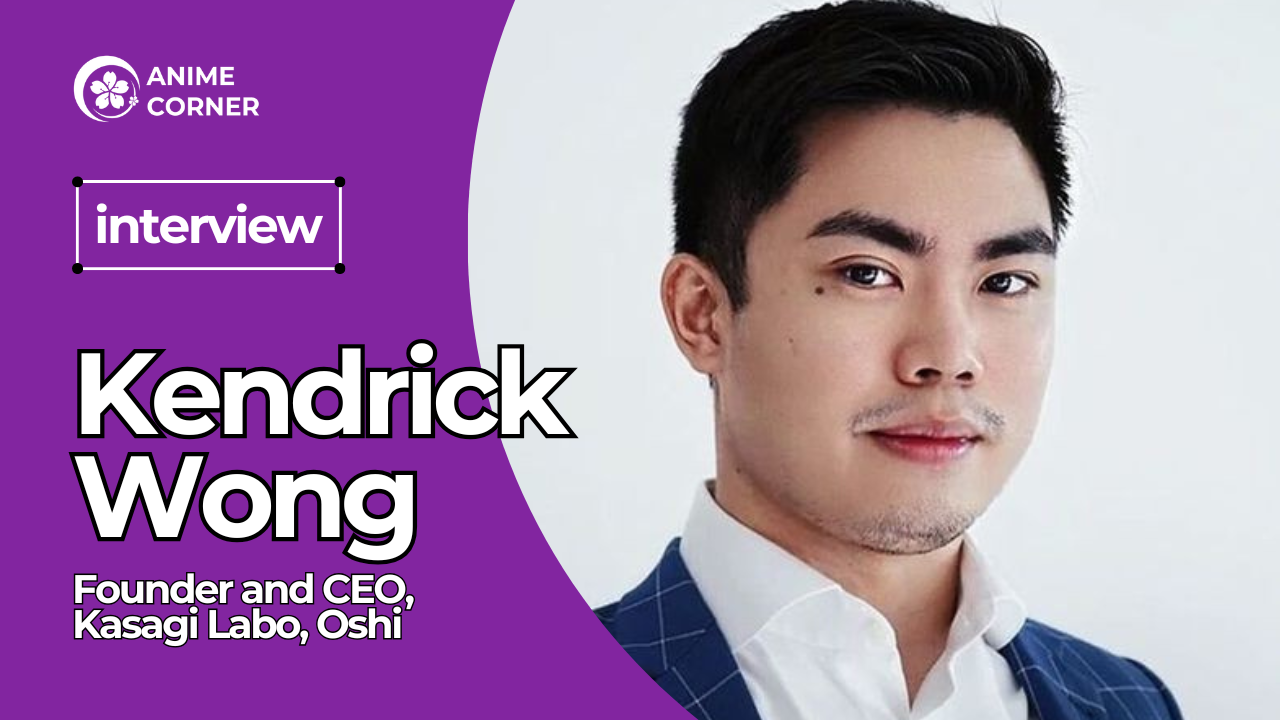Kasagi Labo burst onto the scene a few years ago with millions in funding, anime industry veteran advisors in tow, and international partnerships through acumen accumulated over several years. Attention increased following the announcement of GATE 2 this year, the surprise sequel to the popular GATE anime that aired over a decade ago. Kasagi Labo will produce the anime, with partner company and licensing outfit Oshi also on the production committee, Genco as an associate producer, and Studio M2 (Pluto) responsible for animation production.
Anime Corner caught up with Kendrick Wong, the CEO of Kasagi Labo and Oshi, to understand how both companies differ, collaborate, and what their unique proposition is to anime fans and other stakeholders. We explore how Kasagi Labo aims to overturn established norms with a mix of nascent and polarizing technology, such as blockchains and artificial intelligence, and the major international co-productions they have in the works.
Q: Could you tell us about Kasagi Labo’s path to today and the milestones that led to this latest one: securing GATE 2’s anime adaptation rights?
Wong: Kasagi Labo aims to bridge Japan’s legendary creators to global audiences hungry for authentic anime storytelling. Securing the rights to adapt GATE 2 reflects years of careful relationship-building and respect for Japanese creative traditions. Now that we have two anime under active development and have a growing fanbase, it’s time for us to launch our next fund: a $33M anime production fund to bring even more beloved stories to global audiences. We have already secured potential sequels to classics such as Ninja Scroll or revitalizations of properties like Casshan. So GATE 2 is just the beginning of reviving legacy creations into our era.
Q: Kasagi Labo has spotlighted its ability to forge connections with Japanese creators, which has helped it acquire licenses. Anecdotes of overseas companies trying to forge these connections with Japanese companies have often made the experience sound quite daunting. Could you walk us through any challenges and misconceptions–the overall reality of these experiences–and how your veteran advisors have supported this?


Wong: Conducting business in Japan is about patience, trust, and demonstrating genuine commitment to creators’ visions. GATE 1, whose positive reception and proof of commercial success years ago led us to discover there was still a strong fanbase, laid the groundwork for us reaching out and securing the rights for GATE 2.
Our advisors collectively have long careers in Japanese production houses, anime IP licensing, and investing in creator relations. They guide us through the often slow but crucial steps: respecting cultural norms, being transparent about budget and creative control, understanding how Japanese IP holders think about legacy and brand, and sometimes waiting years to establish trust.
Those same qualities are what led us to another anime IP that will be in the second anime production fund: Casshan. Casshan is a perfect example of legacy done right. While the anime originally aired in 1973 by Tatsunoko Productions, it has since spawned multiple reboots, which showed us its enduring appeal and how deeply Japanese creators value both innovation and honoring the past.
With our next $33M anime fund, we can offer something very concrete. We will put real resources behind legacy IPs like Casshan to bring them back using modern production. We want to make sure our investors and LPs are aligned on moving in that direction. This fund signals we are serious partners, able to honor those legacies while also pushing forward new stories.
Q: With GATE 2 and Special Kid Factory coming up at Kasagi Labo, how do anime projects like this typically originate? What’s the process for evaluating whether an anime is viable?
Wong: When evaluating anime projects, we look at narrative strength, genre alignment with global trends, production feasibility, and international reach. GATE 1’s success gave us proof that audiences respond to stories with depth and unique worldbuilding, which made GATE 2 a natural continuation. For originals like Special Kid Factory, the calculus is different: because there is no built-in fan base, we carefully assess whether the themes and story have the universality to resonate.
Special Kid Factory stands out as a bold shonen sci-fi adventure. Its premise—an ordinary boy discovering his cloned counterpart and uncovering a darker conspiracy—offers layered themes of identity, courage, and moral questioning. These qualities align with current anime market growth (valued at $34B in 2024 and projected to grow nearly 10% annually), where audiences are drawn to philosophical sci-fi and action adventure. This genre not only has staying power in Japan but also has broad international appeal, making it a strong candidate for global distribution.
What makes this approach possible is our new $33M anime production fund. The first fund allows us to take creative risks on originals like Special Kid Factory while balancing the portfolio with legacy IPs that carry established brand recognition in our second fund. Titles like Casshan, a 1973 classic that has inspired multiple reboots and remains a touchstone in anime history, show how timeless properties can be revitalized alongside new stories.
In essence, we believe anime viability lies in balance: honoring proven franchises like GATE and Casshan, while nurturing bold originals that have the potential to define the next generation. The $33M fund provides the resources to do both, creating a pipeline that takes into consideration global audiences and investors.
Q: What is Kasagi Labo’s typical process for creating its anime planning proposals? Such as typical headings/considerations–the things you’re ensuring you’re nailing down before a project really gets underway.

Wong: Every anime project we consider starts with three pillars: data, creative conviction, and long-term scalability. Before any production proposal moves forward, we conduct a deep diagnostic across five core sections.
First is Market Analytics, which we primarily draw by analyzing audience data from our Anime Oshi platform (both a mobile app and web app), identifying global fan clusters, genre momentum, and long-tail engagement. Next, we look at Creative DNA, or the concept’s narrative, visual tone, and its potential for world-building and transmedia adaptation. Next, we move to Production Structure to ensure studio partners can deliver the intended quality within time and budget. After that, we establish a Monetization plan, whether that’s licensing, gaming, merchandise, and event strategies, and revenue-share splits for creators. Finally, we look at Cultural Resonance to see how the story aligns with contemporary themes and emotional arcs that global audiences connect with.
Only once these areas are mapped do we green-light a project internally. Our upcoming $33 million second anime production fund is built around this same framework, which allows us to systematically vet and scale multiple titles simultaneously while maintaining creative depth.
Q: How have these considerations impressed partners, and what are the things that Kasagi Labo is uniquely able to consider in creating its plans and implementing from its plans?
Wong: Traditional anime planning often relies on intuition and legacy relationships. We complement that heritage with predictive analytics and startup discipline. Partners tell us that what surprises them most is our clarity of vision since we arrive with financial modeling, fan sentiment data, and even projected social-media virality curves.
This blend of creative understanding and quantitative rigor is appreciated in anime. It’s why Japanese studios, investors, and even Western entertainment companies have started approaching us to co-finance or co-produce. Our model gives them a roadmap they can trust, and our follow-on $33 million fund ensures we have the capital to act quickly when the right opportunities appear.
Q: Oshi is on the GATE 2 production committee alongside Kasagi Labo. You’re co-founder and CEO of both companies; Oshi has described Kasagi Labo as its “first partner.” Could you help clarify the relationship between Oshi and Kasagi Labo? Is Oshi a vehicle where you hope for future partners to acquire equity, jointly invest, and provide/co-produce IP, or will Oshi remain separate but form pacts to enter production committees together with partners?

Wong: Oshi is an IP licensing platform, while Kasagi Labo is the anime investment and production company. Oshi analyzes what fans love and how they behave; Kasagi Labo applies that intelligence to fund and produce anime. Oshi isn’t a subsidiary; it’s an innovation partner. Kasagi Labo was Oshi’s first production ally, proving that creators and fans can co-shape a title from concept to distribution.
Going forward, Oshi will form additional production pacts with new partners—studios, investors, even brands—who share our vision for transparent, data-led anime creation. The two companies work symbiotically: Oshi gathers insight; Kasagi Labo deploys capital and executes.
Q: Kasagi Labo has spotlighted its desire to give fans greater transparency into how licensing terms are negotiated. How do you balance maintaining a competitive advantage by keeping these things a secret versus having those terms in the open, and how will your approach to transparency transform outsiders’ (e.g., fans’) engagement in a long-lasting way?
ALSO READ:
Kasagi Labo’s KISSUI to Showcase Anime Apparel, Collectibles at NYCC
Wong: Transparency doesn’t mean publishing contracts; it means giving visibility into how value flows. Fans should understand why a title costs what it does, and creators should see how revenue is shared. By opening this window, we build trust that ultimately compounds brand equity. The details of pricing or deal terms remain confidential, but the structure: creator-first royalties, revenue-sharing models, ethical production practices, is clear.
That transparency turns fans into informed supporters instead of the way they’re normally treated: as just consumers. It’s one reason our soft launch for GATE 2 drew unusually high engagement metrics in its first weeks.
Q: Does that transparency close off possible avenues for companies that don’t want those sorts of details in the open? How do you persuade them?/Do you even attempt to persuade them?





Wong: Most companies in the industry only offer opacity as it’s the safest route. We don’t force anyone to change, and we work with our partners to open avenues that they’re in agreement with. Through this partnership model, we demonstrate that openness increases value. Once strategic and venture partners see that transparency attracts both fans and investors, hesitation fades. We’ve converted skeptics simply by showing performance data from Oshi’s engagement dashboard, so transparency reflects back to our growth strategy and shows concrete results.
Q: With the emphasis on fandom involvement in anime pre-production and beyond, where are the areas that you see fans being able to influence a work while still giving creators the space and enjoyment to create?
Wong: Fans provide directional input, but not editorial control. It would be a free-for-all without some safeguards. Fans can vote on things like key-art variants, theme-song artists, or merchandise concepts, which are all elements that personalize the experience without dictating storylines. Creators still own the narrative arc and innovative storytelling. We simply give them real-time feedback to gauge what resonates. We intend to continue striking that balance for titles in our $33 million fund pipeline.
Q: What are the upcoming forms of fandom interaction that you’re most excited about?

Wong: One of my personal favorites is co-development credits. Fans who participate in early production cycles will see their names in the credits, bridging emotional ownership and recognition that they supported us from the beginning. Second, AI-powered personalization. We’re testing generative systems that let fans generate art or music inspired by a series while respecting IP boundaries. Imagine remixing your favorite scene’s background score to match your personal creative expression within defined creative parameters. It would be an entirely new way to make fandom interactive.
Q: What will Kasagi Labo be for the anime creators on the ground? This is in light of concerns over tight production schedules, pay, and copyright restrictions often preventing creators from sharing in the work after it’s released—but also that with Kasagi Labo being an example of anime creators from across the world getting together, this might come with different perspectives, such as different views on forms of creative expression and workflows.
ALSO READ:
Sci-Fi Mystery Anime Special Kid Factory by NAZ Studio Reveals First Trailer
Wong: Kasagi Labo aims to rebalance the economics of anime. Our contracts allocate higher revenue shares directly to animators, designers, and writers, versus the status quo, which allocates the lion’s share to just IP holders. We also standardize fair-pay clauses and build production buffers so studios aren’t pushed to the brink. Because our fund finances full productions, we can ensure studio payment better than contracts positioned for after broadcast. We work with creators who bring new workflows and perspectives from Japan, Southeast Asia, and elsewhere to create a strong culture of creativity.
Q: In the past and today, there have been Kickstarters and limited-time campaigns to support anime production and creators. And naturally, legal streaming is often touted as a means “to support the original creators.” Still, there isn’t currently a concerted effort by many streaming platforms, overseas licensees, and Japanese licensors to enable a more frequent, direct financial connection to creators. Why do you think that is, and how will Kasagi Labo ensure that there will be that long-lasting, meaningful way to support creators directly?
ALSO READ:
GATE Season 2 Officially Announced After Over 10 Years, New Studio and Staff
Wong: Streaming platforms primarily make their money on subscriptions and so their number one marker of success is user retention. Because streaming platforms do not get creator royalties, there is no incentive for them to plow resources into redistribution or brand-strengthening activities. The business model at Kasagi Labo rewrites that dynamic. We treat every show as a micro-economy: merchandise, events, collectibles, and digital experiences feed directly back to creators. The demand is high, which is why we’ve launched a second anime production fund.
We’re establishing transparent royalty dashboards so fans can literally see how their engagement benefits the people who made the show. That’s a radical shift from “support the creators” rhetoric when we can point to a screen and show anyone measurable impact.
Q: Blockchain×Anime collaborations have often used generative AI for things like collectibles. What do you envision generative AI’s role will be in fan experiences, and how does generative AI fit into anime production for GATE 2 and projects in the future?
Wong: We see AI as an assistive layer that supports in-between animation, background enhancement, and localization in production. For fans, it powers interactivity through custom wallpapers, character voice filters, and AI-narrated recaps. This is in the beginning stages, and our policy is clear that AI is assisting human creators, but can never replace them.
Q: Kasagi Labo has discussed opening up the licensing process. What’s your ideal future when it comes to how third parties, like entrepreneurs, content creators/influencers, small & large businesses, and fans, can interact with IP? Will it be through more conventional direct negotiations with Kasagi Labo, or through generic terms of use at scale, etc.?

Wong: I want to move toward a permission-based ecosystem where entrepreneurs, creators, and even fans can license micro-uses of IP under transparent, standardized terms, the same way software usage is conducted for APIs. Instead of endless and patchwork negotiations, you could license a clip or character use instantly under preset conditions. Our internal team is already developing the digital infrastructure to manage those rights securely and fairly.
Q: Where is Kasagi Labo currently in terms of its ideal licensing strategy being ready to meet demand?
Wong: We’re midway. We’ve unified global licensing under one in-house team, eliminating fragmented regional agents. The next phase involves rolling out smart-licensing protocols and that will coincide with the deployment of the $33 million fund into several new titles. When complete, small creators, influencers, and businesses will be able to collaborate with our IPs at unprecedented speed and clarity.
Anime belongs to everyone who loves it. Dedicated fans should impact the anime before it hits screens worldwide. Every view, comment, collectible, and event fans engage with directly supports the artists who built the world we love.
Q: What is Kasagi Labo’s message to fans?
Wong: Kasagi Labo is evolving the industry, and with the $33 million second anime production fund, we’re doubling down on the promise of more access, transparency, and anime that exists because fans engaged with us and we listened.
Many thanks to Layla Tabatabaie for coordinating this interview with Kendrick Wong, whom I’m grateful to for the level of detail and insight provided into Kasagi Labo and Oshi’s futures. The official GATE 2, Kasagi Labo, and Oshi websites are available at the links provided.
ALSO READ:
Full-Scale Anime Production! 4,000-Word Interview With Edia on Anime Production & IP Development Aspirations







